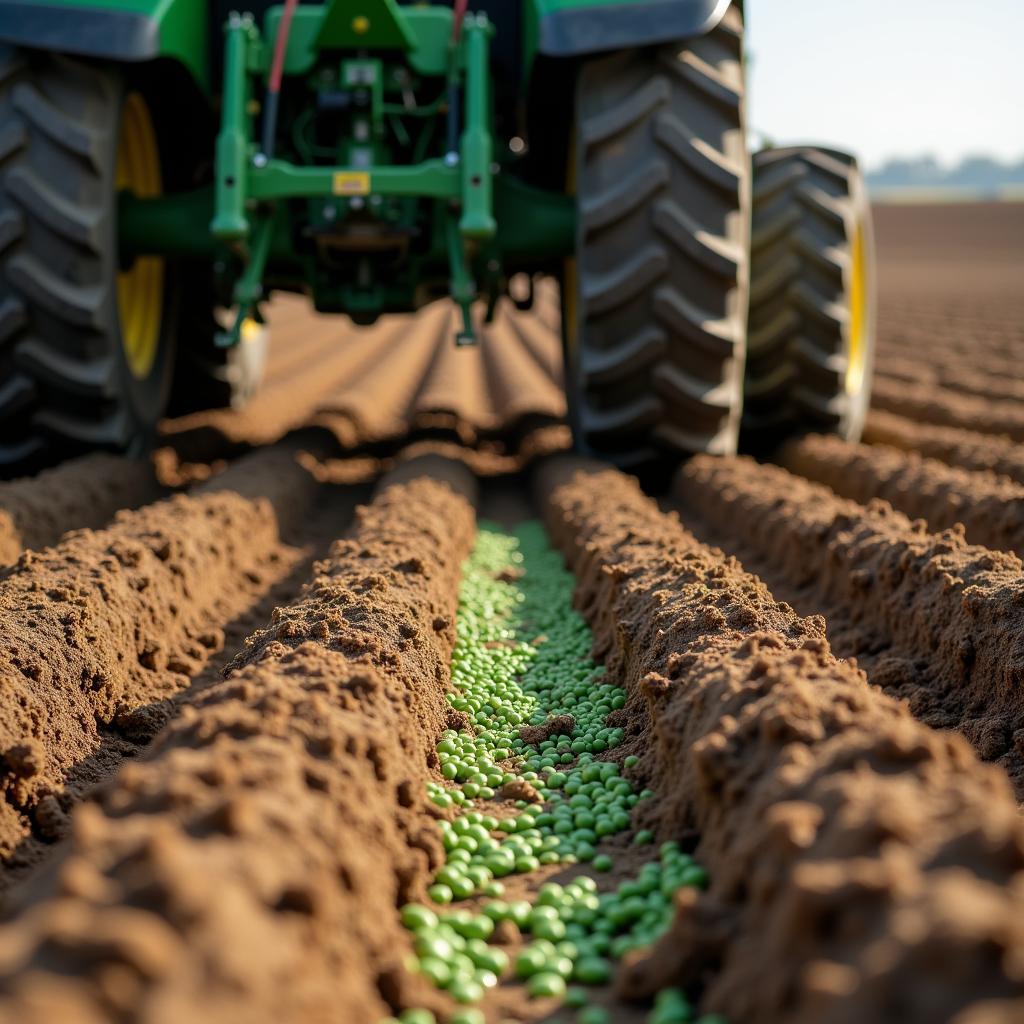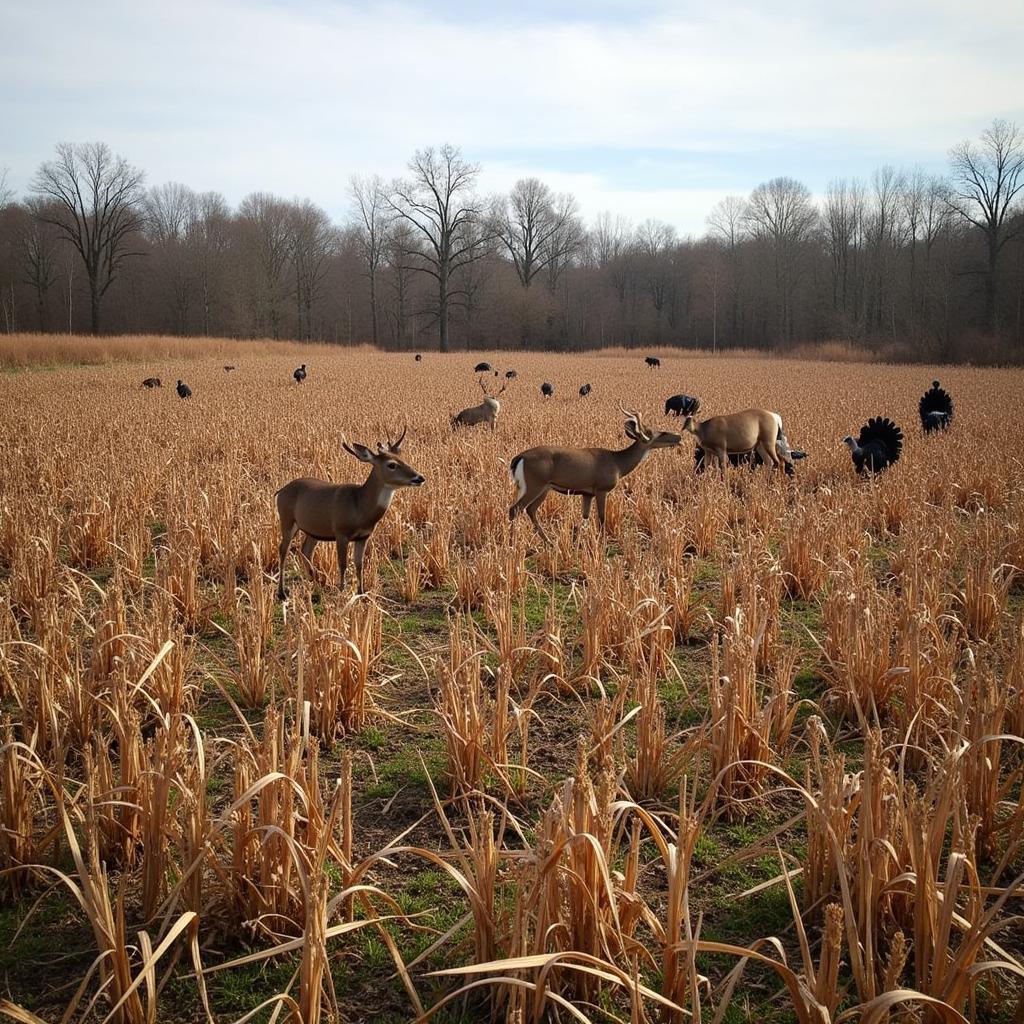Winter peas offer an excellent food plot option, providing crucial nutrition for deer and other wildlife during the harsh winter months. Establishing a successful Winter Peas Food Plot involves careful planning and execution, but the rewards are well worth the effort. This guide will equip you with the knowledge and strategies you need to create a thriving winter peas food plot that will attract and sustain wildlife throughout the winter.
Why Choose Winter Peas for Your Food Plot?
Winter peas are a popular choice for food plots due to their high protein content, cold hardiness, and ability to improve soil health. They are a cool-season legume that provides excellent forage for deer, turkeys, and other wildlife, especially when other food sources are scarce. Planting winter peas also adds nitrogen to the soil, benefiting future plantings.  Deer grazing in a lush winter peas field
Deer grazing in a lush winter peas field
Benefits of Winter Peas
- High Protein: Winter peas offer a crucial protein boost for wildlife during winter, contributing to healthy growth and antler development in deer.
- Cold Tolerance: These hardy plants can withstand harsh winter conditions, providing a reliable food source even in freezing temperatures.
- Soil Improvement: As a legume, winter peas fix nitrogen in the soil, improving soil fertility and benefiting future plantings.
- Attracts Diverse Wildlife: Winter peas attract not only deer but also other wildlife such as turkeys and rabbits, creating a diverse ecosystem.
Preparing the Soil for a Winter Peas Food Plot
Proper soil preparation is essential for a successful winter peas food plot. summer deer food plot mix Before planting, test your soil pH and adjust it if necessary. Winter peas thrive in a slightly acidic to neutral pH range (6.0-7.0). Clear the area of existing vegetation and till the soil to a depth of 4-6 inches. This will create a seedbed that promotes good seed-to-soil contact and encourages germination.
Soil Testing and Amendment
Testing your soil is a crucial step to ensure the success of your winter peas food plot. A soil test will tell you the pH level of your soil and whether you need to add any amendments like lime or fertilizer.
Clearing and Tilling
Removing existing vegetation and tilling the soil creates an ideal environment for winter pea seeds to germinate and grow. Thorough tilling also helps to incorporate any necessary soil amendments.
Planting Your Winter Peas Food Plot
The best time to plant winter peas is in the fall, typically 6-8 weeks before the first expected frost. deer food plot seed mix The seeds should be planted at a depth of 1-2 inches. A seeding rate of 50-60 pounds per acre is generally recommended. After planting, lightly rake the area to cover the seeds and ensure good soil contact.  A farmer planting winter peas using a seed drill
A farmer planting winter peas using a seed drill
When to Plant
Planting time is critical for winter pea success. Planting too early can result in disease issues, while planting too late may prevent the plants from establishing before winter sets in.
Planting Depth and Rate
Proper planting depth ensures optimal germination and seedling emergence. Planting too shallow can expose the seeds to drying out, while planting too deep can hinder seedling growth.
Maintaining Your Winter Peas Food Plot
Once your winter peas are established, minimal maintenance is required. However, keeping an eye on potential pests and diseases is important. when to plant turkey food plots If you notice any issues, consult with a local agricultural extension office for appropriate control methods.
Pest and Disease Control
While winter peas are generally hardy, occasional pest and disease problems can arise. Regular monitoring and prompt action can help prevent significant damage.
The Benefits of a Winter Peas Food Plot for Wildlife
A thriving winter peas food plot offers a sanctuary for wildlife during the lean winter months. food plots for turkeys The high protein content of winter peas provides essential nutrients for deer, supporting healthy growth and antler development. Other wildlife, such as turkeys and rabbits, also benefit from this valuable food source.  Deer and turkeys foraging in a winter peas food plot
Deer and turkeys foraging in a winter peas food plot
Nutritional Value for Deer
Winter peas are a valuable source of protein for deer, crucial for maintaining body condition and promoting antler growth, particularly during the challenging winter season.
Attracting Other Wildlife
A winter peas food plot can also attract other wildlife species, such as turkeys and rabbits, enhancing the biodiversity of your property.
Conclusion
A winter peas food plot is a rewarding investment for any landowner looking to support wildlife populations. By following these guidelines and best food plot for deer and turkey year round dedicating time and effort to proper planning and maintenance, you can create a thriving winter peas food plot that will provide essential nutrition and habitat for wildlife throughout the challenging winter months. Remember the importance of a winter peas food plot for sustaining healthy wildlife populations.
FAQ
- What are winter peas?
- Why are winter peas good for food plots?
- When should I plant winter peas?
- How do I prepare the soil for a winter peas food plot?
- What maintenance is required for a winter peas food plot?
- What are the benefits of winter peas for wildlife?
- Where can I buy winter pea seeds?
For any assistance, please contact us at Phone Number: 02437655121, Email: minacones@gmail.com Or visit us at: 3PGH+8R9, ĐT70A, thôn Trung, Bắc Từ Liêm, Hà Nội, Việt Nam. We have a 24/7 customer support team.